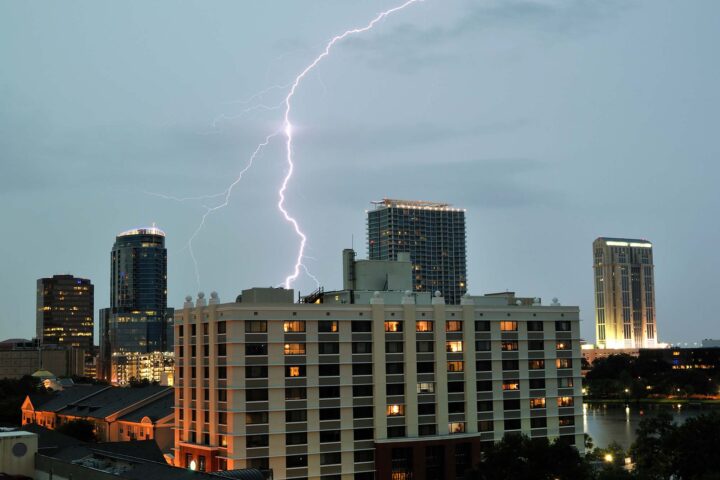Thunderstorms are a regular occurrence during the spring and summer months for large swaths of the United States. As storm systems sweep across the country, the collision of warm tropical air with cooler, drier air to the north, known as a front, triggers these storms. However, this happens much more frequently in the stormiest cities in the US than in other areas.
Using official climate data from NOAA, we’ve compiled a list of the 10 stormiest cities in the US based on the average number of days with thunderstorms per year. So grab your umbrella and join us on this tour of our country’s stormiest locales.
What is the stormiest city in the US?
You might be surprised that the state with the most thunderstorms yearly is also called the Sunshine State: Florida. The top five stormiest cities on our list are all in Florida. That’s because the summer heat and the state’s notoriously high humidity create the perfect conditions for thunderstorms to form almost daily.
If you want Florida to live up to its nickname, visit during winter.
- Fort Myers, Florida: Fort Myers tops our list with an average of 89 thunderstorm days yearly.
- Tampa, Florida: Just a few hours north of Fort Myers, Tampa holds the number two spot with 82 thunderstorm days per year. Lightning often illuminates the city’s famous skyline.
- Tallahassee, Florida: Florida’s capital city is no stranger to storms, with an average of 81 thunderstorm days yearly. The city’s residents are well-prepared for the rumble of thunder and crack of lightning.
- Orlando, Florida: The city known for its theme parks and tourist attractions—most notably Walt Disney World—also gets its fair share of thunderstorms. Visitors and residents can expect about 80 stormy days per year in Orlando.
- West Palm Beach, Florida: Adding to Florida’s stormy reputation, West Palm Beach has an average of 79 thunderstorm days yearly. The city’s beautiful beaches are occasionally interrupted by the dramatic display of stormy skies.
- Lake Charles, Louisiana: We leave Florida behind and head to Lake Charles, Louisiana. This city experiences an average of 76 thunderstorm days yearly, making it the stormiest city outside of Florida.
- New Orleans, Louisiana: A city known for its vibrant culture, New Orleans also sees its fair share of storms. The Big Easy averages 75 thunderstorm days per year.
- Baton Rouge, Louisiana: The state capital of Louisiana, Baton Rouge, is another city with frequent thunderstorms. It has an average of 74 stormy days per year.
- Mobile, Alabama: Our first entry from Alabama, Mobile, sees an average of 73 thunderstorm days yearly. The coastal city is known for its historic architecture, rich history, and stormy weather. It’s also one of the rainiest US cities, measured by annual precipitation.
- Jackson, Mississippi: Rounding out our top 10 list is Jackson, Mississippi, with an average of 72 thunderstorm days yearly. Despite the frequent storms, the city boasts a diverse culture and rich history, making it an interesting place to visit.
When do the stormiest cities in the US typically see the most thunderstorms?
If you’re a fan of stormy weather, consider visiting these cities between June and September, typically the stormiest months in the above locations. Of course, most people would rather avoid stormy weather while on vacation. Additionally, the Deep South is the hottest and most humid at this time, so visiting in Spring and Fall will be drier and far more comfortable.
However, there’s one massive caveat to this. Tornado season starts early in this part of the country, typically by March or April, before ramping up in what is traditionally known as “Tornado Alley.”
Why are these states so stormy?
The stormiest cities in the US are primarily located in two regions: the southeastern United States and the Gulf Coast. The stormy weather in these regions is primarily due to warm, moist air from the Gulf of Mexico meeting cooler air from the north, creating ideal conditions for thunderstorm formation.
Additionally, these areas are prone to tropical storms and hurricanes, which can bring even more thunderstorms to the region. In Florida, the unique peninsula shape and its position between the Atlantic Ocean and the Gulf of Mexico also contribute to the high frequency of thunderstorms.

In conclusion, if you love stormy weather or want to experience the raw power of nature, the cities on our list are prime destinations for you. The southeastern United States and the Gulf Coast are rich in culture, history, and thunderstorms. Just remember to pack an umbrella and be prepared for the awe-inspiring spectacle of Mother Nature at her most dramatic.
Experience the fascinating world of weather with the second edition of Weather Watch: An Introduction to America's Weather and Climate. This book doesn't just explain weather and climate concepts—it brings them to life.
Weather Watch is perfect for teenagers and adults who wish to deepen their understanding of the dynamic world of meteorology. Simplifying the complex, this book breaks down the science of weather into smaller, easily digestible concepts, allowing you to build on your knowledge with each chapter.
Here's what to expect:
- Detailed insights on clouds, pressure and wind, reading weather maps, hurricanes, and tropical storms
- Enlightening discussion on climate change
- Essential guidance on purchasing a weather station
- Critical information on severe weather and tornadoes
- Learning how to forecast the weather yourself
This second edition comes completely reformatted with over 30 pages of new content, including advanced weather map analysis and space weather. It's more visually appealing with additional illustrations and graphics. Each chapter now ends with handy links for more in-depth learning, and sprinkled throughout the book are captivating American weather events, serving as real-life illustrations of introduced concepts.




